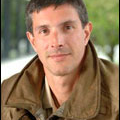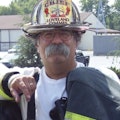In October, the nation honors America's fallen firefighters with National Fallen Firefighter Month. At deadline, approximately 90 firefighters this year have given the ultimate sacrifice in the name of this profession. This month's column examines some of the ways a thermal imager (TI) can help us reduce the number of brothers and sisters we lose.
Get OneIt's been over 15 years since thermal imagers became practical for the fire service. In that time, the cost of a TI has dropped roughly 60%, along with dramatic reductions in size and weight. Any imager manufactured in the past 10 years or so is immune from the old "white-out" problems. The newest Tis perform at levels previously unimagined, so the lower prices clearly do not indicate poorer performance.
There is no reason for a department not to have a usable thermal imager. Sure, there may be excuses, but there is no reason. Yes, budgets are tight. However, adding a thermal imager to the purchase of a new $200,000 engine company adds less than 5% to the overall cost; it's less than 2% for a $650,000 ladder company. Before you order gold-leaf lettering and chrome wheels, place an order for a TI.
Thermal imagers give firefighters the ability to see many of the dangers that are claiming lives. Firefighters need thermal imagers; sending them into a fire blind should not happen any more.
Use ItA thermal imager helps no one if it stays on the truck. That may seem obvious, but there are plenty of departments around the country that regularly deploy firefighters without a TI, even though one is available at the scene. Regardless of the reason, it has to stop. The thermal imager needs to come off the truck at each and every fire. Assign it to a specific person as a mandatory tool to ensure that it doesn't get left behind. Practice regularly with deploying and using a TI with your other firefighting tools.
Get MoreOnce you have one thermal imager, and use it regularly, you will realize that one is not enough. In fairness to the firefighters working on the scene, one is not enough. To effectively protect and assist your firefighters, you need three thermal imagers at each structure fire. Yes, three.
The fire suppression crew needs a thermal imager for their own safety, as well as to help locate the fire faster. The ventilation/search company needs a TI for their own safety, as well as to help find victims and vent points faster. And the rapid intervention company needs a thermal imager for their own safety, as well as to help locate a lost or injured firefighter faster.
For some smaller departments, this may mean just one TI on each truck or at each station. For larger departments, this may mean a TI on each engine or at each firehouse. Placing the TI on a chief's car (battalion or otherwise) has regularly shown to be ineffective. The chiefs normally arrive too late for the first companies to use the TI, and frequently the TI is forgotten until sometime after the fire is extinguished.
Firefighter SafetyThree of the most significant threats faced by firefighters at structure fires are the fire, structural compromise and disorientation. A thermal imager can help a trained firefighter avoid major hazards from all three threats.
The fire, and the superheated gases that it generates, can be problematic when areas in the structure contain large amounts of heat, or hide that heat. A trained firefighter can identify thermal layers within the structure, specifically noting how close they have dropped to the floor. A thermal layer near the floor is a precursor for a flashover.
Fire hidden behind walls or within a drop ceiling will heat the surfaces visible to the TI. This helps firefighters identify where the fire is, as well as where it is headed. Instead of chasing a fire or, worse, being surprised by a fire, crews can get ahead of a hidden fire.
Structural problems are more easily seen with thermal imagers. Holes in the floor will generally have a different thermal signature than the floor itself, making them visible on the TI. A TI can view compromised ceilings and roofs through the smoke, showing joists that are burned through or trusses that are missing.
Regular scans with a TI help a firefighter develop a complete mental image of the structure. A firefighter's image of the building is not limited to what he feels during a blind search. He can see where windows and exits are, as well as any furniture or obstructions near the center of the room. Hoselines or rope lines from other crews will be evident, allowing crews to avoid duplicate efforts and recognize crossing paths.
ConclusionIt is 2007 and we are still losing 100 or more firefighters a year. Yes, some of the duty deaths are health related; others are driving related. But you have a tool that can all but eliminate the losses due to fire-related causes. Thermal imagers give firefighters the ability to see in a structure and avoid concentrations of heat, find hidden fire, identify structural problems and stay oriented.
A fire chief from Ohio once told me, "There is no excuse now for sending firefighters into a building blind." Maybe he is right…there shouldn't be any excuses.
Visit the Technology section of Firehouse.com to view various thermal images related to firefighter safety.
JONATHAN BASTIAN is a thermal imaging specialist for Bullard. He is certified as a thermal imaging instructor by the Law Enforcement Thermographers' Association (LETA). He is also the author of the FD Training Network "FireNotes" book, Thermal Imaging for the Fire Service. Bastian served 12 years on the North Park, IL, Fire Department, including the last three as a captain. He has taught classes on thermal imaging, rapid intervention teams and search and rescue operations. He is currently a public safety official in Central Kentucky. If you have questions about thermal imaging, please send them to [email protected].
About the Author

Jonathan Bastian
Magazine Staff
Billy Goldfeder
BILLY GOLDFEDER, EFO, who is a Firehouse contributing editor, has been a firefighter since 1973 and a chief officer since 1982. He is deputy fire chief of the Loveland-Symmes Fire Department in Ohio, which is an ISO Class 1, CPSE and CAAS-accredited department. Goldfeder has served on numerous NFPA and International Association of Fire Chiefs (IAFC) committees. He is on the board of directors of the IAFC Safety, Health and Survival Section and the National Fallen Firefighters Foundation.
